The Korean light SPG
The M-1977 122mm self propelled (SP) gun/howitzer is another typical North Korean product, a mix between the mass-built VT-322 APC coupled with the 122mm D-30 gun-howitzer, with enclosed sides and open top. It is called more simply "M 1977" as its real designation is unknown to this day by western/asean Intel services. The M1977 designation was allocated by the US Department of Defense, based on year this system was first observed by US intelligence. But it is dated 1976 as a matter of common understanding that it was likely built and designed a year before being introduced and observed.This North Korean artillery system was adopted probably as early as 1976 indeed, with a design perharps goinf back to 1975, based on a request to use the lass-built VT-322 chassis already for other uses. This model is widely used to this day and probably the most common derivative of the chassis. It was never exported outside North Korea. The VT 323 chassis has been used for a large variety of self propelled guns, artillery pieces such as the present the 122 mm D-30 known either as the M1977 and M1985, the difference being mainly been in terms of superstructure with the M1985 being seemibly a more mature and long-term model production model which, without the towing hook of the field gun visible on the M1977. But they shared otherwise the same rear-mounted, open-topped casemate.
The M1977 used the M1973 armored personnel carrier chassis, lightly armored, in which a D-30 standard gun-howitzer is probably bolted-on to enable some traverse. The D-30 is probably the most common warsaw pact and soviet-built gun-howitzer of the cold war, with a 122mm caliber. Conjectures about the production puts an average figure depending on sources of about 900 vehicles, given the estimated numbers of North Korean Artillery Divisions. Find the full article on the VT-323 on tank encyclopedia, archive.
About the M 1973 (VT-323) APC

The 323 armored personnel carrier has been in service and mass-produced in North Korea since the early 1970s and its is the mainstay armored personnel carrier used by North Korea, which chassis was used for a wide variety of self-propelled artillery pieces and multiple rocket launchers, anti-tank or anti-air systems, as well as the M1981 Shin’heung light tank’s hull. It is apparenly based on the Soviet PT-76 of which many are still in North korean service, largely degraded into multiple chassis types. Unlike the original it is much shorter, with just five stamped roadwheels per side. It was found sturdy enough to carry many offensive payloads.
About the 122 mm howitzer 2A18 (D-30)
The 122 mm howitzer 2A18 (D-30) is a Soviet-designed artillery piece that was introduced in the early 1960s. It is a towed howitzer that is designed for indirect fire support of infantry and armored units. The D-30 has a range of up to 15.3 kilometers and can fire a variety of ammunition types, including high explosive, fragmentation, smoke, and illumination rounds.The D-30 has a crew of six and can be easily transported by truck or helicopter. It has a split-trail carriage that allows for a wide range of elevation and traverse, making it highly versatile on the battlefield. The weapon is also equipped with a muzzle brake and a recoil mechanism that helps to reduce the recoil forces during firing.
The D-30 has been used extensively in conflicts around the world and has proven to be a reliable and effective weapon system. It has been used by the armies of many countries, including the Soviet Union, Russia, and various other countries in Eastern Europe, Asia, and Africa.
As for performances, the D-30 Maximum range is 15.3 km with the standard High-Explosive Fragmentation (HE-FRAG) shell. It can be up to 21.9 km with rocket-assisted shells. The standard High-Explosive (HE) shell was showed capable of defeating 180 mm steel armor plate, making the M 1977 a potential armored vehicle killer as well. In fact a wide range of ammunition was developed for the D-30 and it's likely North Korea had access to the Chinese former variants of these, manufactured locally.
Design of the M 1977
The VT-323, vehicle on which this vehicle is based, is kept intact wiht its original chassis, engine and transmission in the nose and same drivetrain, location of the pilot at the left, with a MG gunner behind and the commander on the other side's hatch, opposite the driver. The latter is given a classic three panoramic set of periscopes, and presumably an IR sight for night driving.It's in the former personal compartment that the magic is operating. It had flat, enclosed sides and is open top. Protection is limited to ground-level small arms fire, and artillery shell splinters to some extent. In the field and when travelling, this open top can be covered with bows and canvas cover, protecting the crew from weather hazards.
The M1977 is a far cry to the Soviet 2S1 Gvozdika and inferior in many respects, due to its crude WW2 style configuration. Modern SPGs are all turreted for crew safety reasons and NBC protection. The D30 installed in the compartment could be lowered down on a locker, although phitos shows always the latter erected. It has a semi-automatic sliding wedge breech improving firing rate for circa 6-8 rounds per minute down to 1-4 rounds per minute sustained. The vehicle and howitzer are served with a total of 8-9 personal, and video shows that they are trained to be able to start firing three minutes after the M1977 arrived in position. When firing, it is helped by two large stabilizing spades at the rear, lowered firmly into the ground when commencing firing.
For passive protection of the vehicle, the crew's firearms is the only answer to a close-in attack. As said above, the basic vehicle's armour only protects frontally against 14 mm HMG fire, the sides against small arms fire. The open configuration forbids any use of NBC protection, other than collective and for active concealment, although there are no smoke projectors, but it is always possible to sprinkle oil into the exhaust, "soviet-style" in order to offer a smoke cloud.
Mobility
The M1977 self-propelled howitzer is driven by the same power unit as the VT-323, it was provided a Deutz BF8L413F diesel engine, rated for 320 hp and capable of 60 km/h. When swimming it was 4-5 km/h, for a range of 400 km. It could climb a gradient of 60%, a side slope of 30%, a vertical step of 0.6 m and gap a trench of 2 m. It is fully amphibious like the original although deprived of the rear-mounted waterjets of the armored personnel carrier and thus, it is propelled when swimming by its tracks. It can ford also waterways (lakes and rivers) without preparations or issues. But in now way it is fit for shore operations. Even a choppy water would soon go above the open compartment's side with obvious consequences.Operational History
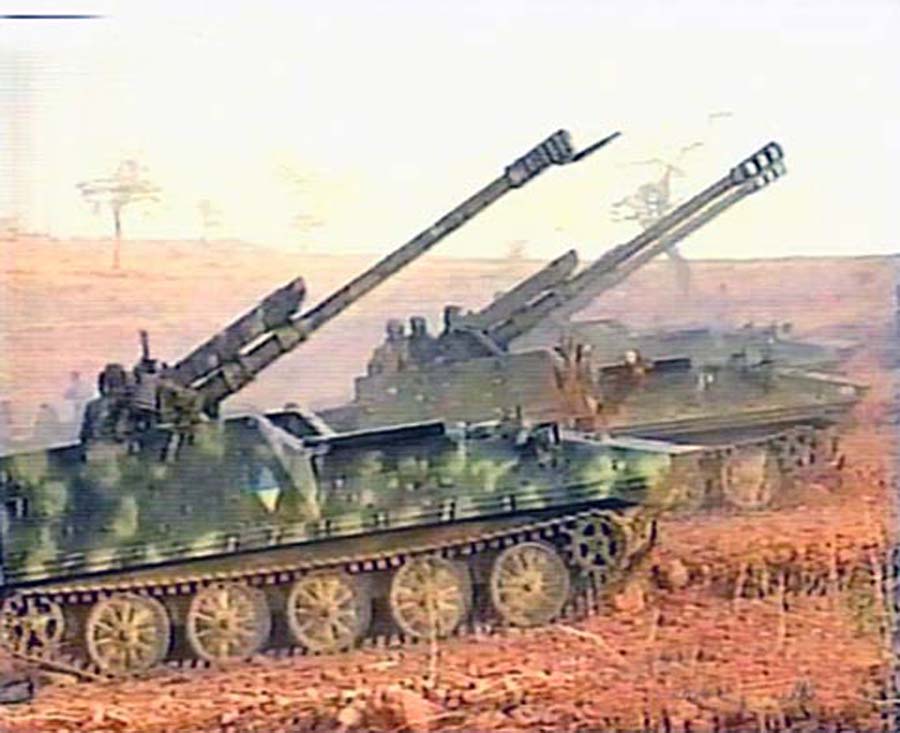
A rare photo of a camouflaged M 1977 in exercizes - via oryxspioenkop
So far there is no sure figure on the vehicle's production, one clue could be the identification of motorized artillery unit, but this data is not available so far. No source so far is giving any reliable number. What is likely is that the M 1977 production was inferior to the M 1985, which seems more refined. It should be said also that the same chassis was used for the 100 mm gun (Soviet BS-3 type) also open-topped, but with a modified rear casemate and same dual-opening rear doors as the M 1977, suggesting it is derived from the turretless variant of the 323. The vehicle is classed as a tank destroyer and was developed apparently in the first half of the 1970s, just like the M 1977.
Sources/Links about the
See also the 323 FSV with 76 mm F-22On military-today.com/
On fas.org
NK visual refs. armoured vehicles on Spioenkop
M1977 specifications | |
| Dimensions | As VT-323, circa 5.5 x 2.9 x 2.7 m |
| Total weight, battle ready | Unknown, c16 t |
| Crew | 6-7 (Driver, commander, 5-6 gun crew) |
| Propulsion | Deutz BF8L413F diesel 320 hp |
| Suspension | Independent torsion bars |
| Speed (road) | Estimated 40mph |
| Range | 400 km estimated (290 mi) |
| Armament | 122mm gun D30 |
| Armor | As VT 323 |
| Total production | Unknown. |
Gallery

Original D30 Howitzer for comparison
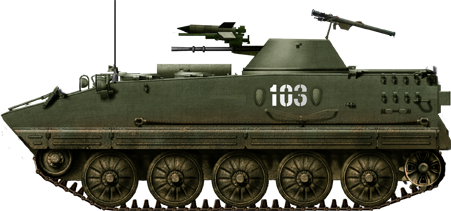
VT 323 APC
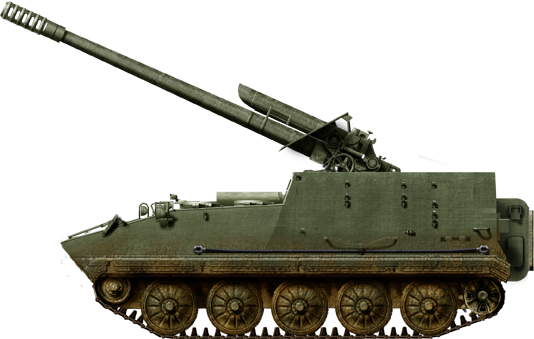
Plain green vehicle, similar to those seen on parade since 1977
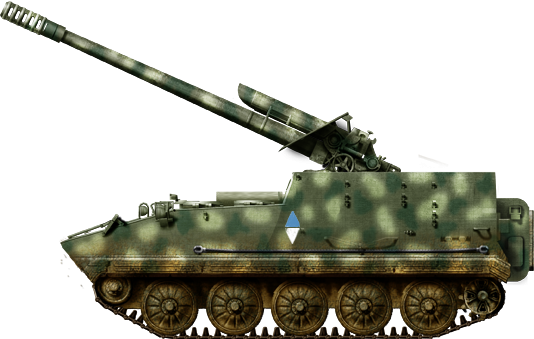
Camouflaged M 1977 in exercises

The M 1985 in parade at Pyongyang, at Kim-Il Sung square. Source: Oryx Blog

M1985, other photo
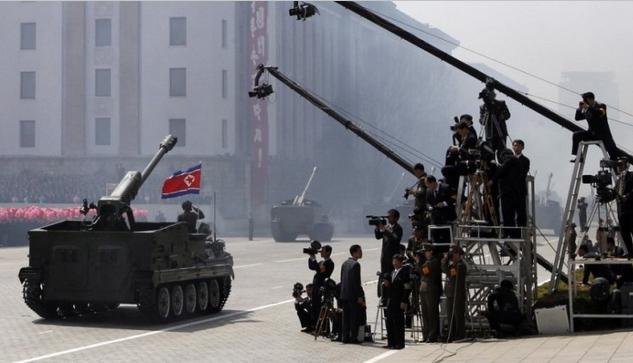
M1977 rear view of the vehicle
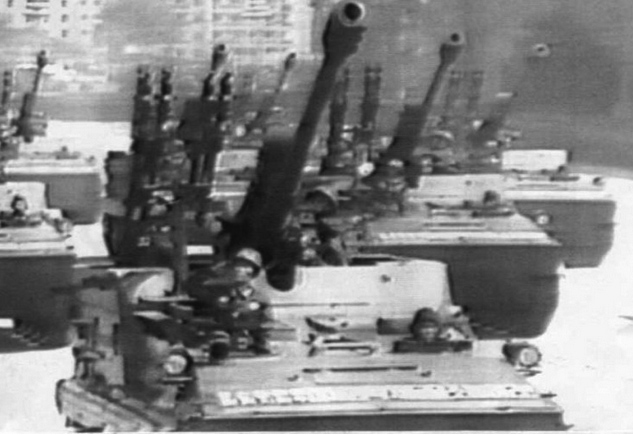
M1977 in Parade, black and white photo
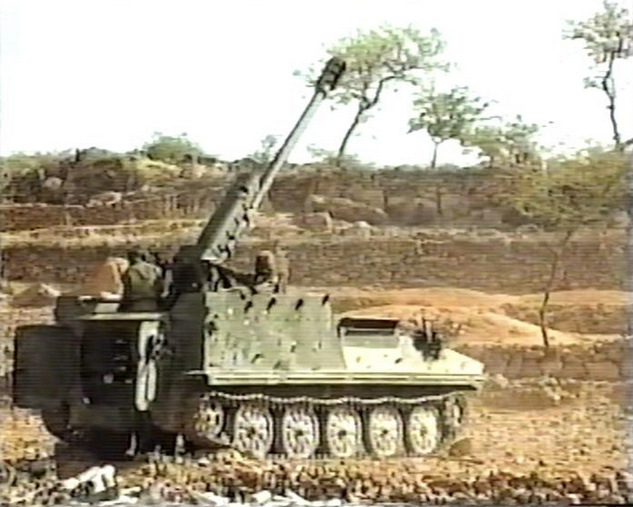
M1977 Rear
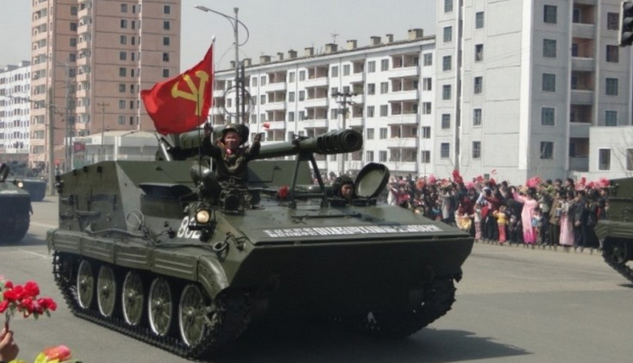
M1977 Parade

Cold War Tanks


































Cold war tanks posters

Cold War Main Battle Tanks

Cold War Soviet Army
Museums, Movies, Books & Games
The Tanks and Armor in pop culture
Tanks and armored vehicles in general are only really grasped when seen first person: The mass, the scale, it's all there. Explore also the way tanks were covered in the movie industry, in books and in video games.Movies:
Best tanks movie on warhistoryonline.com
On imdb.com
On bestsimilar.com/
miltours.com
liveabout.com/
watchmojo.com
Video Games:
pcgamesn.com
historyhit.com
levvvel.com
vg247.com/best-tank-games
mmobomb.com/
alienwarearena.com

